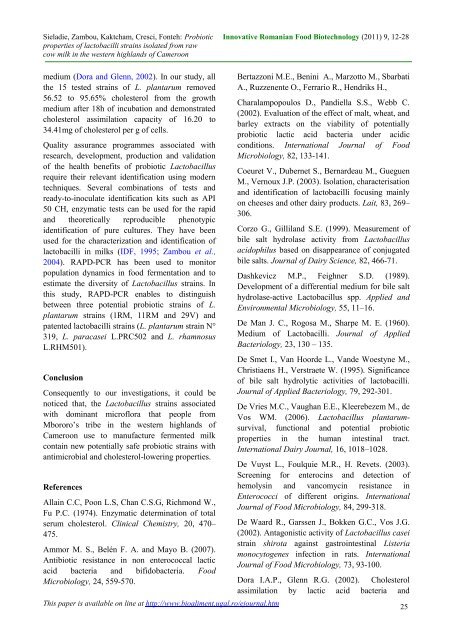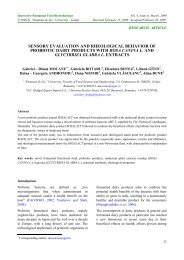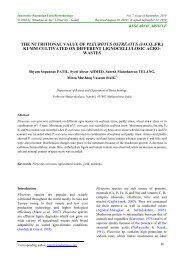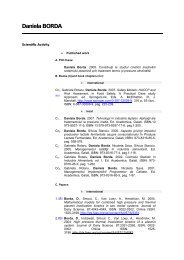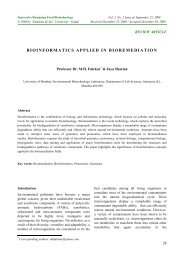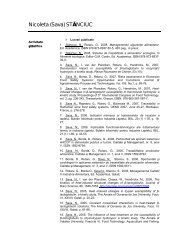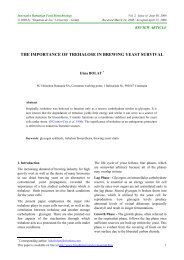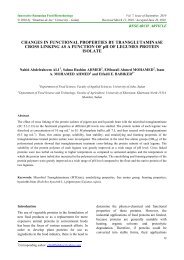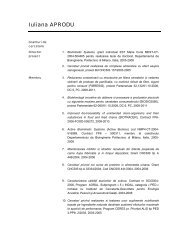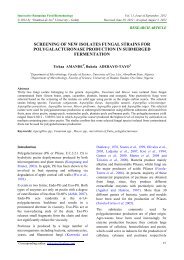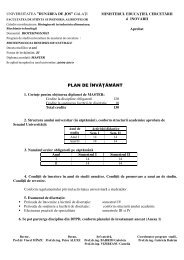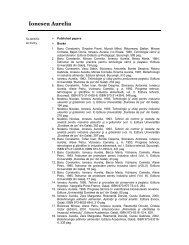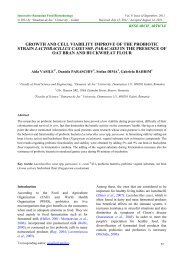probiotic properties of lactobacilli strains isolated from ... - Bioaliment
probiotic properties of lactobacilli strains isolated from ... - Bioaliment
probiotic properties of lactobacilli strains isolated from ... - Bioaliment
Create successful ePaper yourself
Turn your PDF publications into a flip-book with our unique Google optimized e-Paper software.
Sieladie, Zambou, Kaktcham, Cresci, Fonteh: Probiotic Innovative Romanian Food Biotechnology (2011) 9, 12-28<br />
<strong>properties</strong> <strong>of</strong> <strong>lactobacilli</strong> <strong>strains</strong> <strong>isolated</strong> <strong>from</strong> raw<br />
cow milk in the western highlands <strong>of</strong> Cameroon<br />
medium (Dora and Glenn, 2002). In our study, all<br />
the 15 tested <strong>strains</strong> <strong>of</strong> L. plantarum removed<br />
56.52 to 95.65% cholesterol <strong>from</strong> the growth<br />
medium after 18h <strong>of</strong> incubation and demonstrated<br />
cholesterol assimilation capacity <strong>of</strong> 16.20 to<br />
34.41mg <strong>of</strong> cholesterol per g <strong>of</strong> cells.<br />
Quality assurance programmes associated with<br />
research, development, production and validation<br />
<strong>of</strong> the health benefits <strong>of</strong> <strong>probiotic</strong> Lactobacillus<br />
require their relevant identification using modern<br />
techniques. Several combinations <strong>of</strong> tests and<br />
ready-to-inoculate identification kits such as API<br />
50 CH, enzymatic tests can be used for the rapid<br />
and theoretically reproducible phenotypic<br />
identification <strong>of</strong> pure cultures. They have been<br />
used for the characterization and identification <strong>of</strong><br />
<strong>lactobacilli</strong> in milks (IDF, 1995; Zambou et al.,<br />
2004). RAPD-PCR has been used to monitor<br />
population dynamics in food fermentation and to<br />
estimate the diversity <strong>of</strong> Lactobacillus <strong>strains</strong>. In<br />
this study, RAPD-PCR enables to distinguish<br />
between three potential <strong>probiotic</strong> <strong>strains</strong> <strong>of</strong> L.<br />
plantarum <strong>strains</strong> (1RM, 11RM and 29V) and<br />
patented <strong>lactobacilli</strong> <strong>strains</strong> (L. plantarum strain N°<br />
319, L. paracasei L.PRC502 and L. rhamnosus<br />
L.RHM501).<br />
Conclusion<br />
Consequently to our investigations, it could be<br />
noticed that, the Lactobacillus <strong>strains</strong> associated<br />
with dominant micr<strong>of</strong>lora that people <strong>from</strong><br />
Mbororo’s tribe in the western highlands <strong>of</strong><br />
Cameroon use to manufacture fermented milk<br />
contain new potentially safe <strong>probiotic</strong> <strong>strains</strong> with<br />
antimicrobial and cholesterol-lowering <strong>properties</strong>.<br />
References<br />
Allain C.C, Poon L.S, Chan C.S.G, Richmond W.,<br />
Fu P.C. (1974). Enzy matic determination <strong>of</strong> total<br />
serum cholesterol. Clinical Chemistry, 20, 470–<br />
475.<br />
Ammor M. S., Belén F. A. and Mayo B. (2007).<br />
Antibiotic resistance in non enterococcal lactic<br />
acid bacteria and bifidobacteria. Food<br />
Microbiology, 24, 559-570.<br />
This paper is available on line at http://www.bioaliment.ugal.ro/ejournal.htm<br />
Bertazzoni M.E., Benini A., Marzotto M., Sbarbati<br />
A., Ruzzenente O., Ferrario R., Hendriks H.,<br />
Charalampopoulos D., Pandiella S.S., Webb C.<br />
(2002). Evaluation <strong>of</strong> the effect <strong>of</strong> malt, wheat, and<br />
barley extracts on the viability <strong>of</strong> potentially<br />
<strong>probiotic</strong> lactic acid bacteria under acidic<br />
conditions. International Journal <strong>of</strong> Food<br />
Microbiology, 82, 133-141.<br />
Coeuret V., Dubernet S., Bernardeau M., Gueguen<br />
M., Vernoux J.P. (2003). Isolation, characterisation<br />
and identification <strong>of</strong> <strong>lactobacilli</strong> focusing mainly<br />
on cheeses and other dairy products. Lait, 83, 269–<br />
306.<br />
Corzo G., Gilliland S.E. (1999). Measurement <strong>of</strong><br />
bile salt hydrolase activity <strong>from</strong> Lactobacillus<br />
acidophilus based on disappearance <strong>of</strong> conjugated<br />
bile salts. Journal <strong>of</strong> Dairy Science, 82, 466-71.<br />
Dashkevicz M.P., Feighner S.D. (1989).<br />
Development <strong>of</strong> a differential medium for bile salt<br />
hydrolase-active Lactobacillus spp. Applied and<br />
Environmental Microbiology, 55, 11–16.<br />
De Man J. C., Rogosa M., Sharpe M. E. (1960).<br />
Medium <strong>of</strong> Lactobacilli. Journal <strong>of</strong> Applied<br />
Bacteriology, 23, 130 – 135.<br />
De Smet I., Van Hoorde L., Vande Woestyne M.,<br />
Christiaens H., Verstraete W. (1995). Significance<br />
<strong>of</strong> bile salt hydrolytic activities <strong>of</strong> <strong>lactobacilli</strong>.<br />
Journal <strong>of</strong> Applied Bacteriology, 79, 292-301.<br />
De Vries M.C., Vaughan E.E., Kleerebezem M., de<br />
Vos WM. (2006). Lactobacillus plantarumsurvival,<br />
functional and potential <strong>probiotic</strong><br />
<strong>properties</strong> in the human intestinal tract.<br />
International Dairy Journal, 16, 1018–1028.<br />
De Vuyst L., Foulquie M.R., H. Revets. (2003).<br />
Screening for enterocins and detection <strong>of</strong><br />
hemolysin and vancomycin resistance in<br />
Enterococci <strong>of</strong> different origins. International<br />
Journal <strong>of</strong> Food Microbiology, 84, 299-318.<br />
De Waard R., Garssen J., Bokken G.C., Vos J.G.<br />
(2002). Antagonistic activity <strong>of</strong> Lactobacillus casei<br />
strain shirota against gastrointestinal Listeria<br />
monocytogenes infection in rats. International<br />
Journal <strong>of</strong> Food Microbiology, 73, 93-100.<br />
Dora I.A.P., Glenn R.G. (2002). Cholesterol<br />
assimilation by lactic acid bacteria and<br />
25


